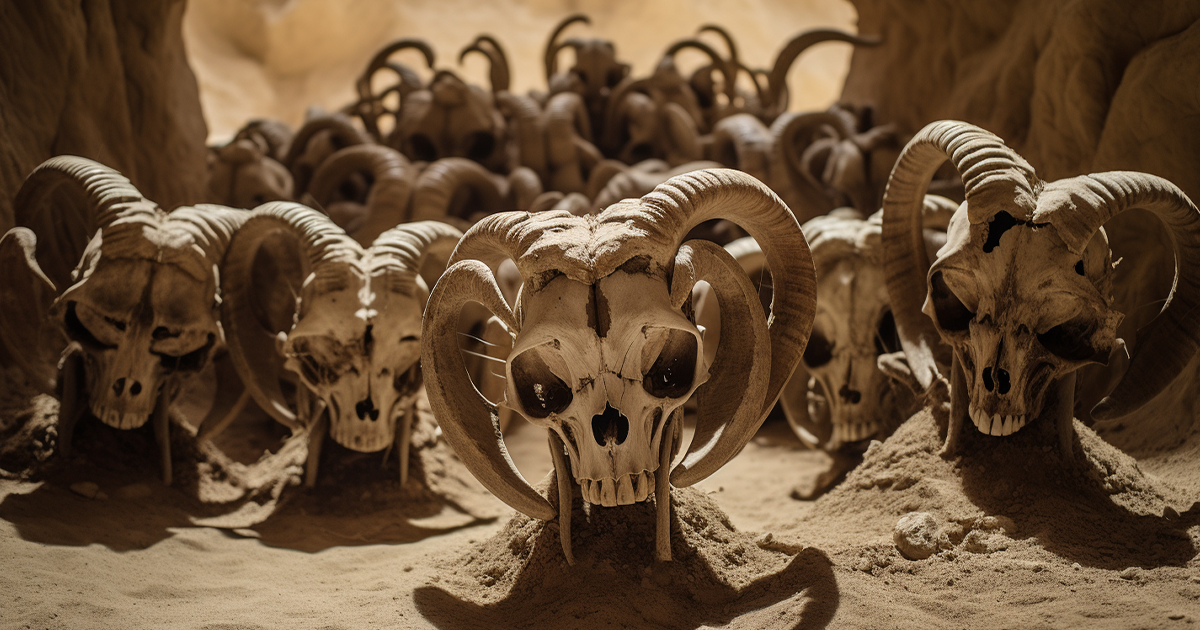Underneath Egypt’s eternal sands lies a realm veiled in enigmas and conundrums, challenging those who wish to fathom its mysterious history. Aidas, a vast temple complex existing for over 5500 years, has captivated archaeologists and history enthusiasts alike with its concealed mysteries. In 2023, a team from New York University uncovered a groundbreaking finding that reverberated across the globe.
As archaeologists meticulously unearthed layers of ancient sand at Aidas, they stumbled upon a remarkable discovery – a collection of mummified ram skulls. What began as a routine excavation transformed into a revelation as they unearthed a staggering total of 2,000 ram skulls, neatly arranged in rows. These were not mere remains but held significant cultural significance as revered artifacts.
The question arises – what drove individuals to preserve and inter 2,000 ram skulls together? The answer might be intertwined with the era of Pharaoh Ramses II, also known as Ramses the Great, the overseer of Aidas’ construction. Theories suggest that these ram skulls were laid to rest as a lasting homage, centuries after his reign.

This astounding revelation gives rise to yet another intriguing query – what befell the bodies of the Rams? Unlike other mummified creatures in Egypt, only the skulls of these Rams were meticulously preserved, shrouding their bodies in mystery.
The enigmatic essence of Aidas reverberates through Egypt’s archaeological chronicles. Over a century and a half ago, the French archaeologist AUST Marette chanced upon an equally perplexing collection of remains, albeit intact.
Marette’s exploration led him to Sakara, known locally as the “cage of monsters.” Situated a mere ten miles south of the majestic pyramids of Giza, this site held a unique reputation among the Bedouin tribes, regarded as an unparalleled burial ground.
While venturing into the vicinity, Marette uncovered a series of chambers housing massive sarcophagi. Twenty-four in total, each measuring an impressive 12x6x6 feet, with lids weighing a staggering 40,000 pounds. The monumental size of these coffins raised questions – what was their purpose, and whom or what were they meant to safeguard against?
The core of this mystery lies with the revered Apis bulls, colossal creatures weighing up to 1300 pounds, venerated as intermediaries between humans and the divine realm. Playing a pivotal role in intricate religious ceremonies dating back to 3000 BCE, each sarcophagus bore inscriptions in ancient Egyptian hieroglyphs denoting the final resting places of the Apis bulls. Hence, the locals’ association with the “cage of monsters.”
Nevertheless, not all occupants of these grand coffins remained undisturbed. Marette stumbled upon a sarcophagus displaying signs of intrusion. Did the creatures escape, or did a daring individual try to plunder its contents? The answer remains as cryptic as the many other unresolved mysteries of Egypt.
In the realm of archaeology, one mystery often begets another, weaving a complex tapestry of unanswered enigmas. The wonders of Aidas and the “monsters’ cage” at Sakara serve as poignant reminders that Egypt’s sands harbor not only the grandeur of ancient civilizations but also the enthralling mysteries that continue to captivate our minds. As we delve deeper into antiquity, we must acknowledge that certain enigmas may forever evade our grasp.
